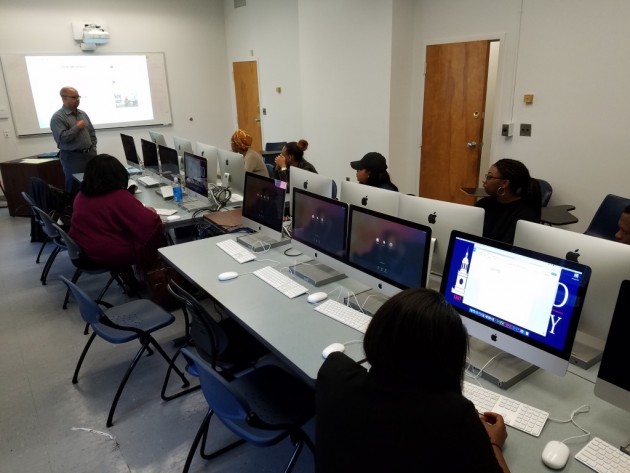Protesters Call for National AIDS Strategy
“DC is still dying,” chanted DC Fights Back Activist Geno Dunnington into the mega-phone.
An energetic, enthusiastic crowd got pumped and ready to march their way towards Anacostia Park in Southeast, to demand safe and affordable housing in the Nation’s Capital for people living with HIV/ AIDS.
A bus load of New Yorkers both HIV positive people and activists and others from around the world joined Washingtonians at Barney Circle Southeast, Wednesday at 10:30 a.m.
The crowd of about 60 people sported grey sweat hoodies which read “DC is still dying,” in dark grey letters on the front and on the back read, “We need a National Aids Strategy Now.”
“What do we want?” asked Dunnington.
“Housing,” the crowd shouted.
“When do we want it?” yelled Dunnington.
“Now,” marchers responded.
Christine Campbell the Director of National Advocacy and Organizing for Housing Works, an organization committed to ending AIDS and homelessness described housing as a structural prevention.
“There is more positive health outcomes when housed than when not housed,” said Campbell.
Speakers spoke about their personal experiences as persons living with HIV, the HIV/AIDS epidemic in Africa and the alarming rate of HIV/ AIDS cases in the Nation’s capital. Three percent of the District’s residents have HIV/ AIDS according to DC Health officials.
Larry Bryant the co-chair of DC Fights Back said a person’s basic life functions, like making a doctor’s appointment are affected when affordable, effective housing is absent.
Across the river where marchers gathered in Anacostia park, Ward 8 has the highest rate of new HIV/ AIDS cases in the District, totaling at 16.1 percent according to a report by the Department of Health.
Dunnington, a third generation Washingtonian of northeast has buried three cousins who were infected with HIV/ AIDS.
The District’s rate for newly reported AIDS cases is higher than rates in Baltimore, Philadelphia, New York City, Detroit, and Chicago. African-American residents account for 57percent of the District’s population and make-up 81percent of the new HIV/ AIDS cases.
Dunnington cites a lack of education and knowledge about the disease as a major factor in the spread of the disease.
Dunnington was in denial after he was diagnosed in 1984, a result of any one of a number of multi-risk factors including substance abuse and unprotected sex. He married and had two children and no one was infected. The marriage lasted a couple of years after his diagnosis until his wife took the car and left him with the children. He finally sought help 12 years later.
At the time, Dunnington said there were no prevention programs, no treatment and there were no condoms. He used his first condom when he was 40-years-old. He is now 52.
“I was young, dumb and stupid,” Dunnington told the crowd.
Today Dunnington, works with DC Fights Back and has a cable television show HIV/ AIDS: The Nation and the World on Comcast 95. The show educates individuals and brings different agencies together in effort to end the HIV/ AIDS epidemic.
This epidemic was the reason why Allison Felix of Brooklyn, N.Y., traveled from her place of origin in Trinidad and Tobago to the U.S. and into the District for the rally.
“My brothers and sisters are dying in my country like dogs,” Felix said.
Felix was diagnosed in September 2008. She was married for 23 years to a man who had the disease.
“I had done nothing wrong,” she said. “I have never smoked even a cigarette.”
Felix described the situation in Trinidad and Tobago as being very bad adding that stigma leads to the death of many.
Her mother who supported her marriage, abandoned her after she was diagnosed.
“The very husband that you spoke about in the wedding and asked for long levity and faithfulness, when he gave me the virus why did you abandon me?” she asked as if speaking to her mother.
Persons with HIV/ AIDS are treated in the worse way said Felix. She said nurses will not come near the infected person and food and other necessities are thrown towards them or slid. After testing positive, Felix said that the nurses share the information of a person’s status with their community. Furthermore, she added that the government does not treat people with the disease and many including herself have to flee to America for treatment.
Of the country’s over 1.3 million inhabitants 14,000 people are living with HIV/ AIDS in Trinidad and Tobago according to a UNAIDS 2008 report.
“Im hurting and what I’m learning today, I’m gonna take back and fight to the last for the people who have HIV/ AIDS in Trinidad and Tobago because people are dying,” Felix said. ” It’s affecting our women. It’s affecting our children.”
Women aged 15-49 in Trinidad and Tobago make-up 59 percent of the HIV/ AIDS cases at the end of 2007. An estimated 500 children were reported to be living with the disease. African-American women constitute 58 percent of the District’s female population, but account for 90 percent of the new female HIV cases. “They are hiding the virus and they are spreading it because they are hiding and they don’t want to be tested,” Felix said. “They feel it makes no sense to know because they will die anyway.”
Heterosexual contact is the leading mode of HIV transmission in the District and in Trinidad and Tobago while nationally men who have sex with men lead new transmissions.
UNAIDS cited a lack of HIV/ AIDS counseling, prevention programs, resources, facilities and confidentiality among healthcare providers and stigma, discrimination and cultural taboos in Trinidad and Tobago as some of the many reasons for the pandemic.
“I am making a plea to the government of Trinidad and Tobago the virus has chosen to live with us, we have not chose to live with the virus please emerge us and bring the medication so that people can be treated,” said Felix. “Please, please, government of the Caribbean we need to bring this under control.”
After the rally, eight activists most were HIV positive met with Jeffrey Crowley the Director for the Office of National AIDS Policy at 2:30 in the White House this afternoon to discuss the ways in which they could all work together to improve the National AIDS Strategy “in order to end the AIDS epidemic.” They also spoke about the 50 Day Report Card that graded President Barack Obama and his administration’s progress in working to establish a comprehensive national HIV/AIDS strategy.
The Obama Administration report card consisted of one grade of “A,” for identifying a high-level person in the White House to lead the National AIDS Strategy and one “B-,” for establishing a process in which people living with HIV/ AIDS will be in leadership in the development of the National AIDS Strategy.
The administration received two incompletes, one for not creating a process for intergovernmental collaboration in the development and implementation of the National AIDS Strategy and the other for not appointing a Global AIDS coordinator. There were also two grades of “C”, and an “F” for failing to house both people on the HIV/ AIDS waiting list and on the low-income housing waiting list.
Among the eight who met with Crowley were Campbell and Dunnington.
“The epidemic is not over for anyone until it’s over for everyone,” said Alex Lawson who spoke briefly to the crowd.
“Who?” Lawson shouted into the microphone.
“Everyone,” the crowd responded.



